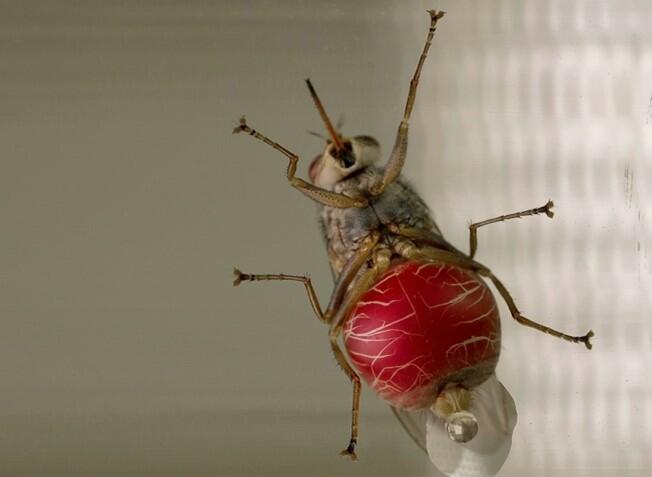
Across most of the animal kingdom, offspring are born smaller than their parents. Surprisingly, several families of insects, including tsetse flies, break this simple rule, and mothers produce offspring their own weight or even larger.

This amazing feat is possible thanks to two main factors. First, tsetse have a diet consisting exclusively of protein-rich blood and they can consume over twice their body weight in blood every few days. This allows mothers to produce thick, highly nutritious, tsetse “milk” that they use to feed their rapidly growing larva. Second, tsetse do not possess the physiological constraints of mammals, such as the pelvic girdle, which prevent birthing of large babies.
Dr. Lee Haines, alongside colleagues at the universities of Bristol, Stellenbosch and California Riverside, have published an essay in the November issue of BioEssays that explores this extreme tsetse reproductive strategy. Producing large tsetse babies carries a consequence that egg-laying insects do not face - female tsetse flies can birth only one baby at a time. This results in a slow life history, in which females must be continually pregnant and long-lived in order for the species to survive.
Dr Lee Haines said: “The thought of a female giving birth to a single offspring that weighs more than she does is difficult to fathom. Since we are all familiar with human babies, which weigh on average 6% of the mother’s pre-pregnancy weight, this feat is unthinkable. Even a blue whale calf, the largest baby in the world, weighing an impressive 2700 kg at birth, is only 1.5% of the mother’s weight!
Now, imagine giving birth to this massive baby every ten days… for the rest of your life. How can natural selection explain this seemingly impossible feat? Additionally, because tsetse give birth to big babies, tsetse biology, survival and the control of vector populations are all affected. I am excited for people to read our essay and I anticipate it will initiate very interesting conversations.”
Tsetse are not only fascinating from a biological perspective, but they also pose serious public health and veterinary threats because they transmit the parasites the cause the fatal human and animal diseases called African trypanosomiases. The essay discusses how understanding the tsetse’s strange reproductive strategy can help scientists reduce fly populations and control disease. Since tsetse larvae remain protected within their mother’s uterus and the pupae are hidden in the soil, controlling tsetse populations is restricted to targeting only adult flies. This contrasts with controlling egg-laying insects, like mosquitoes, where all stages of insect development are susceptible to insect control campaigns. For tsetse, the slow breeding cycle means that you only need to kill a few percent of the adult female flies per day to eradicate a population.

Currently, insecticides applied to cattle and artificial host-like baits, such as “tiny targets” are used successfully to control tsetse populations in disease-endemic areas. Other vector control strategies, like the release of sterile male tsetse or tsetse with genetically altered microbiomes, can be more challenging to implement due to the high costs associated with rearing treated flies and then releasing them into the wild. Although controlling disease transmission should always be the priority, recognising that tsetse are biologically fascinating creatures is also important. Tsetse flies make important contributions to biodiversity and species richness in tsetse-endemic regions, and thus, the unusual life history of these flies warrants their preservation in areas where human and animal health are not threatened.
Big Baby, Little Mother: Tsetse Flies Are Exceptions to the Juvenile Small Size Principle is published in the November issue of BioEssays https://doi.org/10.1002/bies.202000049.
Check out the video “Burrowing for knowledge” to see a short documentary on this BBSRC/RS-funded project led by Prof. Steve Torr at LSTM and Dr. Sinead English at the University of Bristol.